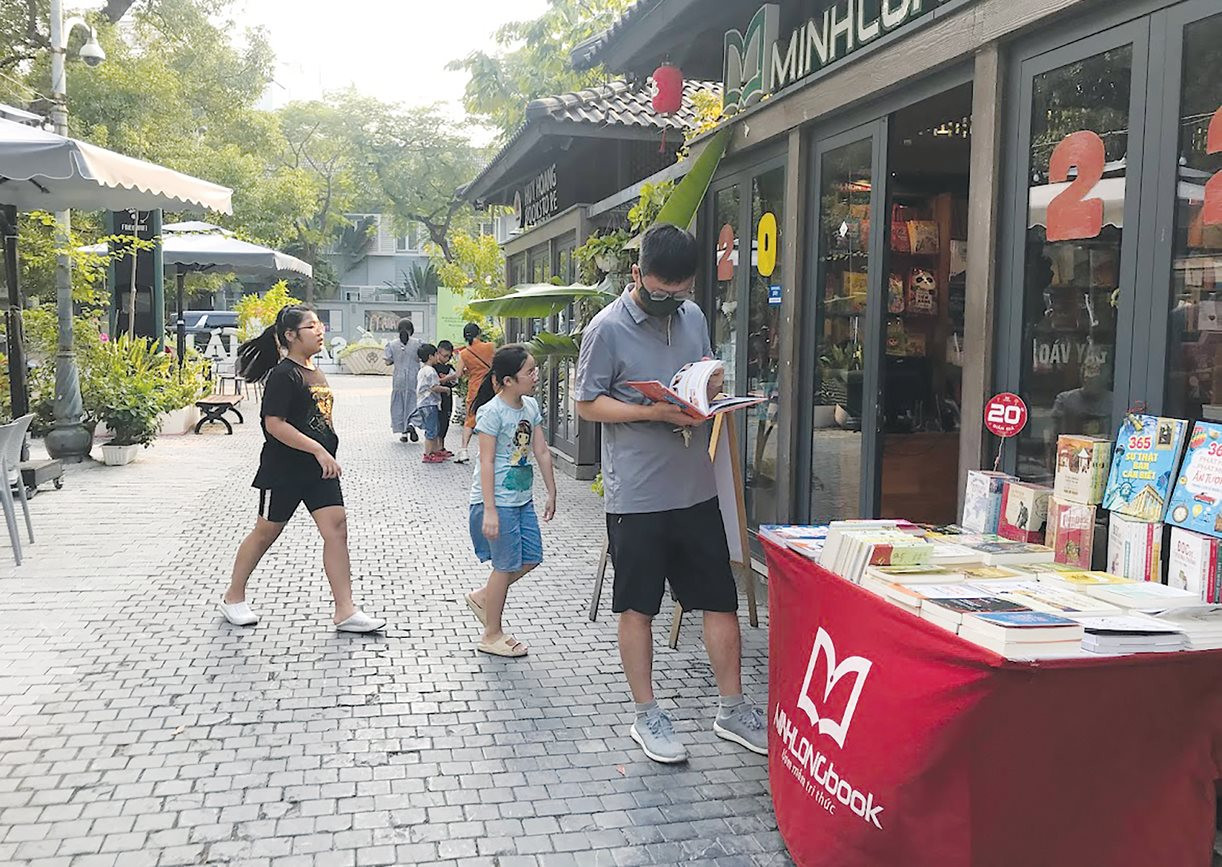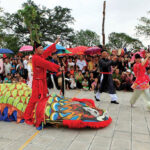In recent years, Hanoi has left its mark with numerous creatively cultural events, the emergence of vibrant creative spaces, and the preservation and promotion of cultural heritage. These efforts have transformed the city into an alluring destination, continually elevating the cultural and spiritual life of its residents. It all signifies a diverse and appealing cultural environment in Hanoi, a place where creative individuals converge, connect, and thrive.

Hanoi Book Street has become an attractive destination for the capital’s residents and tourists. Photo by: Vu Minh
Images of New Hanoi
Amidst the densely populated residential areas in Dong Da and Long Bien districts, old factories have found a new lease on life, donning the guise of creative spaces like Complex 01 and Design 282. Rather than falling into disuse and decay, these locations have become the go-to spots for many young people. They host regular cultural and artistic activities, featuring workshops for handmade crafts, and booths catering to culinary, fashion, spa, and beauty needs.
In late 2022, the citizens of the capital gained additional cultural spaces as the pedestrian zone along Tran Nhan Tong Street and its vicinity was inaugurated, seamlessly integrating with the extensive landscape and lush greenery of Thong Nhat Park. Since then, this space has not only connected the recreational areas around Thien Quang Lake and Thong Nhat Park, forming a comprehensive landscape that meets the needs of locals and tourists for cultural exploration and experiences within the region. It also contributes to enhancing the value of the cluster of historical sites such as Quang Hoa Pagoda, Thien Quang Pagoda, and Phap Hoa Pagoda, while synergizing with the activities of the Hanoi Cultural Center for Students, the Central Circus, the Hanoi Cheo Theater, the French Institute in Hanoi, and the Korean Cultural Center…
More recently, in the ancient village of Duong Lam, the creative space Doai Creative, featuring art performances, workshops, and creative development, was introduced. Transformed from an old structure, Doai Creative brings cultural experiential activities to tourists, adding allure to the ancient village’s charm to “captivate” visitors.
These are just three examples among many creative cultural complexes, public art spaces, pedestrian streets, book streets, etc., that have become attractive destinations for the citizens of Hanoi and tourists in recent years. It can be said that building a cultural environment is a central task that Hanoi has concretized through various activities. Each district and commune in Hanoi clearly identifies its strengths to focus on leveraging advantages, diversifying cultural activities, and tourism products, not only meeting the needs of residents but also attracting tourists from within and outside the country.
For instance, Ba Dinh District aims to capitalize on the values of historical sites and expand cultural spaces based on the potential and characteristics of the district to serve the needs of the people and tourists. The Secretary of the Ba Dinh District Party Committee, Hoang Minh Dung Tien, shared: The people of Ba Dinh are always proud of their historical and cultural land with its distinctive cultural identity, rooted in the Thap Tam Truai region that has existed for 980 years along with the nation’s history. There are 54 traditional festivals organized each year, representing the festive spirit of the local people. In the past, due to the impact of war, many traditional festivals in the district were in decline.
Entering a new phase, especially in the 2020-2025 term, Ba Dinh district clearly recognizes the immense significance of organizing traditional festivals. The District Party Committee has instructed the People’s Committee of the district to restore some festivals that had faded away at historical sites and to upgrade the scale of organizing traditional festivals to meet the religious and cultural needs of the people. Simultaneously, it aims to educate about traditions, express gratitude and respect to preceding generations, and contribute to enhancing the awareness and responsibility of Party committees, governments, mass organizations, political and social institutions, and the various strata of the people in effectively preserving and promoting the values of historical, cultural, and traditional relics.
The evaluation results of the implementation of Program 06 during the 2015-2020 period by the Hanoi City Party Committee indicate that the cultural and spiritual life of the people is increasingly enriched. Investment resources in cultural development have increased by 30% compared to the previous term, with a focus on exploiting the potential and strengths of culture, especially in connection with the development of tourism. Numerous cultural heritages have been preserved, promoted, and turned into attractive tourist destinations. Cultural designs receive attention and investment, innovating their operational methods. The cultural and spiritual life continues to improve, with mass cultural and artistic movements flourishing at the grassroots level. The role of literature and art is affirmed, and proactive international cultural exchange and cooperation are evident with the organization of numerous prestigious, high-quality cultural and artistic events in the capital. Specific policies and mechanisms have been established to create a legal foundation for cultural development, with a central focus on enhancing the quality of the workforce and building elegant and civilized Hanoians.

Le Mat village festival has many unique folk cultural activities. Photo by: Nhat Anh
Expanding Horizons for Creativity
In tandem with the implementation of the national solidarity movement to build a cultural life, focusing on constructing new rural areas, civilized urban centers, fostering cultural families, cultural villages, cultural residential clusters, and cultural offices and units meeting the cultural standards, Hanoi has laid emphasis on adhering to the two behavior codes issued by the city. The network of cultural and sports facilities has received significant attention and investment. As of the first quarter of 2023, the entire city boasts 383 cultural and sports facilities under the management of the municipal People’s Committee, departments, committees, and unions. All 30 districts and towns have Cultural-Information and Sports Centers featuring 84 cultural and sports facilities. Moreover, 125 out of 579 communes, wards, and towns have central cultural and sports facilities, and 85% of villages and cultural residential clusters have cultural centers or community activity points.
The city has a specific orientation for planning a system of cultural centers along both sides of the Red River, urban greenery planning linked to the upgrading, renovation, and construction of parks. The development of three cultural spaces has been completed to meet the needs of residents and visitors for cultural enjoyment, exchange, cultural activities, entertainment, and culinary exploration every weekend. These spaces include Son Tay Ancient Citadel pedestrian street, Tran Nhan Tong pedestrian street (Hai Ba Trung District), and Dao Ngoc – Ngu Xa culinary street (Ba Đình District).
Hanoi has opened another door for organizations and individuals to foster creativity, leading to more frequent and diverse cultural and artistic activities. By intensifying the development of cultural spaces, Hanoi provides an opportunity for cultural enjoyment among its residents while nurturing a wellspring of creative inspiration within the community.
Associate Professor Dr. Nguyen Van Hieu, Dean of the School of Interdisciplinary Studies at the Vietnam National University, Hanoi, notes, “In recent times, through various exhibitions, festivals, and displays, Hanoi has gradually introduced to the public an image of a creative, youthful, and dynamic community. However, all of this seems insufficient compared to the length of history and the creative potential that the local community possesses. A decisive factor to truly make Hanoi a creative city in design is for this field to become a vital source in nurturing intellectual development and contributing directly to the daily economic life of the local community.”
Cultural development is synonymous with human development. According to Dr. Dang Thi Phong Lan (University of Fine Arts of Vietnam), Hanoi will need to put in more effort into building cultural and artistic projects, and events, and creating valuable products in both cultural and economic terms. This is crucial to elevate the awareness of the people, with creativity being a directional force and the youth as the primary resource.
For the capital city of Hanoi to genuinely become a converging, crystallizing, and driving force for creativity, culture must truly be the impetus for the city’s development. Cultural development should be on par with economic and social development, where resources are concentrated on human factors, heritage, and cultural infrastructure.
https://hanoimoi.vn/phat-trien-van-hoa-dong-luc-cho-su-phat-trien-ben-vung-thu-do-bai-cuoi-de-van-hoa-tro-thanh-dong-luc-sang-tao-623703.html

